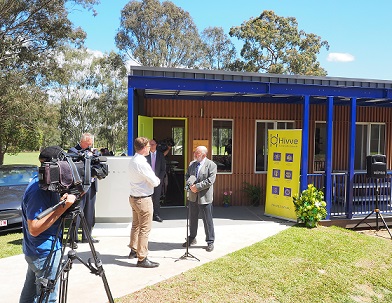
On Wednesday, The Educator reported on what is claimed to be Australia’s first ‘off the grid’ classroom, being trialled at Bracken Ridge State High School in Brisbane.
The revolutionary pilot project is run by Hivve Technologies Pty Ltd, which received more than $370,000 from the Australian Government, the Australian Renewable Energy Agency (ARENA).
Below, The Educator speaks to Bracken Ridge State High School principal, Roger Atkins, about the initiative, as well as how other schools might benefit financially and academically from making the switch to renewable energies.
TE: This is a clearly a revolutionary step for a school to take. Why was the decision made to take the classroom ‘off the grid’?
RA: The building was always going to be solar-powered, energy efficient and the building’s timber completely upcycled, however to connect the Hivve with power and data to the nearest we were quoted in excess of $60,000. As a result our school and Hivve explored alternative energy storage options in order to ensure the building could be off-grid. The building is now powered by a Tesla battery, which stores excess solar energy for use on cloudier days as well as to heat in the morning and cool during the summer, and data via extended Wi-Fi services. These decisions were ultimately based on proof of concept and we’re very pleased the building is truly sustainable.
TE: I understand that the school’s classroom uses both solar panels and a Tesla battery. Can you give us an idea of how efficient this has this been for the classroom so far?
RA: A key feature of the building is its energy efficiency and its capacity to provide a refreshing and cooling learning environment – both these features are particularly important in Queensland where we experience warm to hot conditions most of the year. So far we have used the Hivve across a range of winter and spring temperatures (often warm here in Brisbane!) and even with a week of rain, the Tesla battery’s storage has never dropped below 70% stored energy. Even on our cloudiest days, we’ve found the Hivve to be continuously powered by off-grid energy while providing a comfortable reverse-cycle air-conditioned classroom with standard power features (powerpoints, laptop charging, digital projects) for students.
TE: How did the school come to work with Hivve Technology?
RA: Our school is focused on building authentic, long-term relationships with a range of industry, environmental and community organisations and businesses to maximise our students’ learning opportunities. We were approached by Hivve with this concept based on our school’s vision to develop strong partnerships and a culture of wellbeing for students that provides innovative education spaces. In my experience working across Queensland in a range of industries, I had seen firsthand how positive learning friendly spaces can be for all students. This was a major opportunity to participate in an exciting pilot that could benefit Bracken Ridge SHS students and, possibly in the future, students across urban, regional and remote Queensland.
TE: With savings of $3,000 annually on power bills, this is surely a massive financial benefit for the school. Do you envisage that such an initiative could eventually see an ‘off the grid’ school rather than just one classroom?
RA: Our experience thus far has been that savings, both in establishment and ongoing costs, are already significant beyond the projected figures. In the future and not just in cost terms, I think we will see ‘green’ and energy efficient schools not just in Queensland but across Australia especially in terms of delivering comfortable, ergonomic classrooms. In my previous years as a principal in regional and remote areas, I saw firsthand the economic and geographic challenges that left students and teachers struggling in spaces that truly didn’t benefit them with regards to their climate and isolation. We are privileged to be involved in this pilot and I hope this is just the beginning of classrooms that focus on education, environment and sustainable infrastructure solutions.


